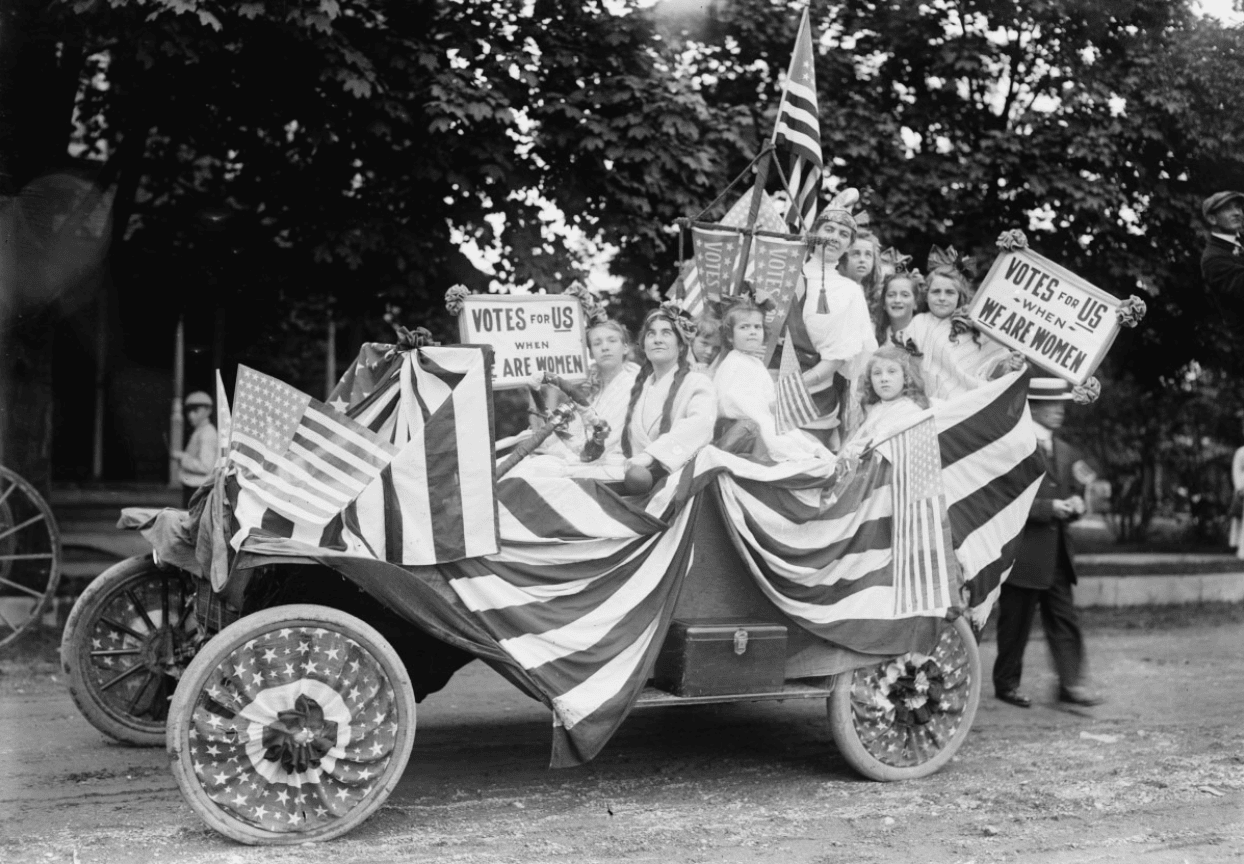Four remarkable Philly trailblazers… and where to go to pay tribute to them.
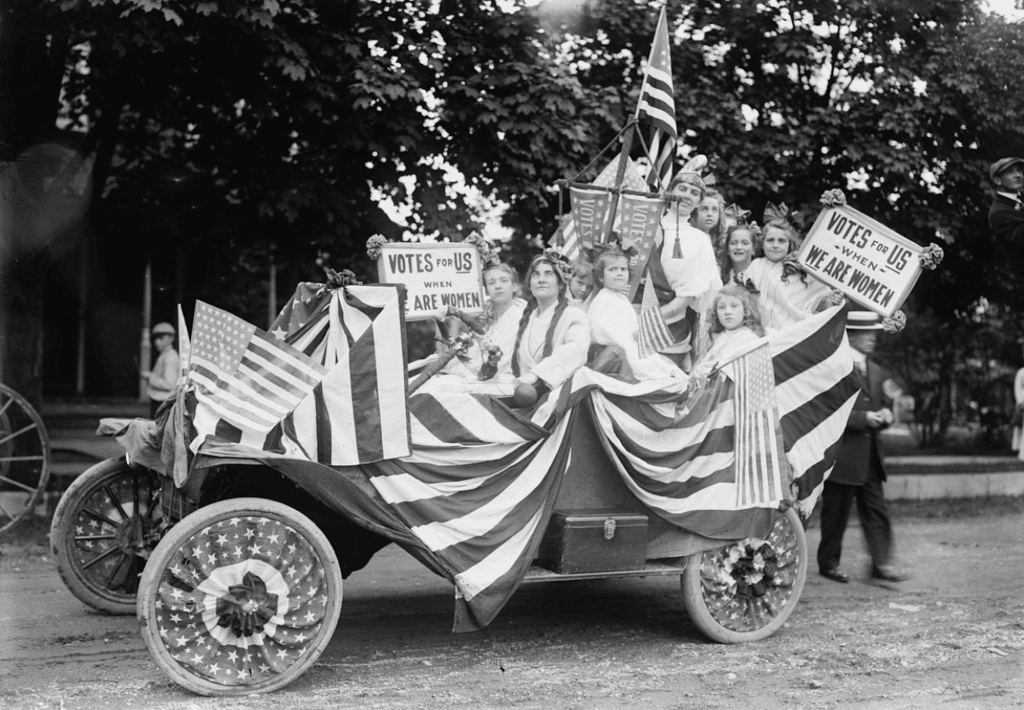
Suffragists in parade, ca. 1910-1915. Photo Courtesy Library of Congress/ Bain News Service
Happy Women’s History Month from Guild House Hotel! If you know us, then you already know that here at our luxury boutique hotel, we have a special connection to the history of Philadelphia women, and to American women as a whole. Housed inside a National Historic Landmark, our hotel in the heart of Philadelphia was once upon a time the headquarters of the New Century Guild—one of the first clubs ever formed for working women in America.
The fascinating, modern women who made up the New Century Guild, founded in 1882, were either professional working women themselves—educators and medical professionals; artists and writers; tradespeople, makers and women in service industries—or those who felt compelled to support working women at a time when much of the country still thought a woman’s place was in the home. In addition to their professional roles, these women were also labor activists, suffragists, abolitionists, children’s welfare crusaders, thought leaders and political influencers—and the guild they formed together offered them friendship, educational classes, entertainment, lodging, meals and more. (You can read the whole story of the Guild, its women and its influence on our site. Should you book a room or book the house and stay with us, you’ll also find that each room is named for a different woman of the Guild.)
Later on—much later on—the New Century Guild would evolve into a private foundation focused on philanthropic work, with a focus on gender justice. The Gender Justice Fund, still active in Philadelphia now, is yet another legacy of the Guild, supporting people and projects that aim to end all forms of gender-based oppression. This March, in honor of Women’s History Month and as a tribute to the women of the Guild, we’re donating five percent of proceeds from our bookings to the GJF. (Come visit us, and be a force of change!)
We’re also very excited to feature our Library of Incredible Women campaign, a project designed to feature great women in Philly today who are emblematic of the spirit of the women of the Guild. Visit our website now to nominate the incredible women you know (in any industry!) supporting other women. Our chosen winners will not only be featured in our social media posts, but will also receive a complimentary stay at Guild House, as well as other goodies. (You can also find Guild House on Facebook and Instagram to watch it all unfold.)
Meantime, here on our blog, we’ve covered in the past some of the other great Philadelphia women whose actions and legacy helped shape the world for future generations. (Betsy Ross! Lucretia Mott! Barbara Gittings!) Now, we’re offering a follow-up to our first installment with four more great Philly women from history whom we love … plus where you can go in Philadelphia to learn more about them and pay homage.
And if this is up your alley? Let us recommend the fabulous Badass Women’s Walking History Tour by the locally owned Beyond the Bell Tours. You’ll get the fascinating stories of still more women who built and shaped this city, from entrepreneurs to medical pioneers to politicians—a true history of Philly that’s often gone untold.
Here’s to all of these women, and all the rest—past and present—who have brought us to this moment, and who have shaped and are shaping our lives, our vision, our creativity, our sense of freedom, our experiences and our reality.
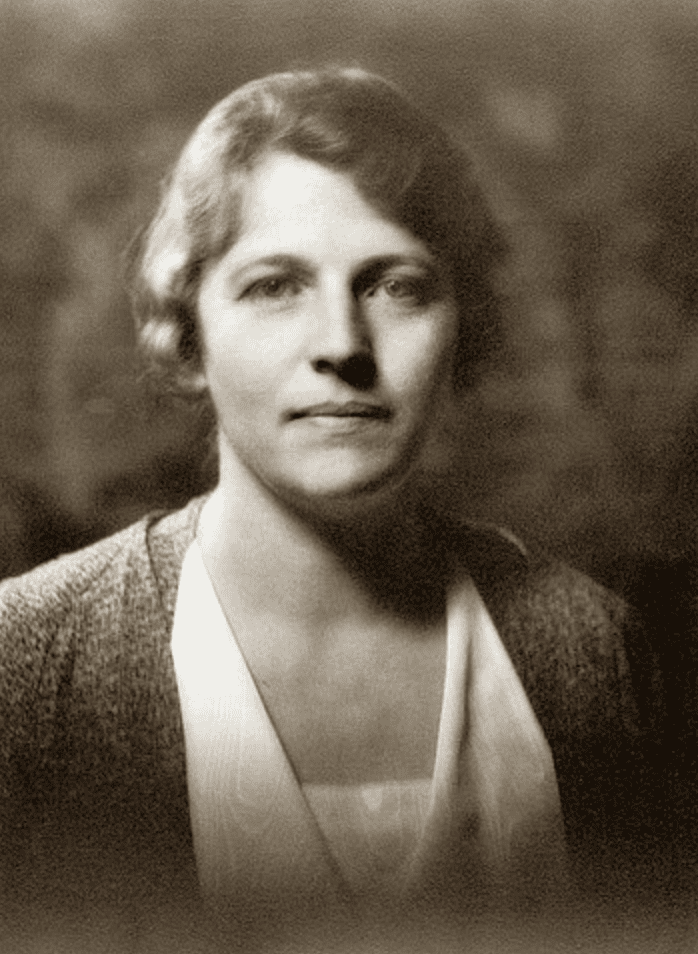
Photo of Pearl S. Buck by Arnold Genthe, from United States Library of Congress‘s Prints and Photographs division
Pearl S. Buck
The prolific writer and Pulitzer-Prize winning Pearl S. Buck—she won the award for The Good Earth, in 1932—was the first woman to ever win the honor. Six years later, she’d also be the first woman to win the Nobel Prize, this time for her entire body of work. If we’re honest, her ties to Philadelphia are slightly tenuous: She was born in West Virginia in 1892, and grew up in China, the daughter of missionaries. Later, as an adult, she lived again in China, where she wrote The Good Earth, a novel about peasant life in the country in the 1920s, known for its rare (at the time) sympathetic and loving depiction of the Chinese people and culture.
After moving back to the states, she eventually found herself living in Bucks County outside Philadelphia with her husband and a houseful of both adopted and foster children. There, she continued to build a legacy as writer, as a humanitarian and as a bridger of cultural divides by advocating for and humanizing the marginalized people of the world, including here in the U.S., where she pushed for civil rights. She founded the world’s first international biracial adoption agency, and founded the Pearl S. Buck Foundation in Philadelphia (which still exists today as Pearl S. Buck International) aimed at providing humanitarian aid and child sponsorship around the globe.
Today, her former farmhouse in bucolic Bucks County offers visitors a glimpse at the life of the writer and humanitarian: The National Historic Landmark is also a museum. Take in her typewriter, library, a collection of family possessions, the beautiful grounds and award-winning gardens, her gravesite, and more. You can also opt for a docent-led tour of the historic house.
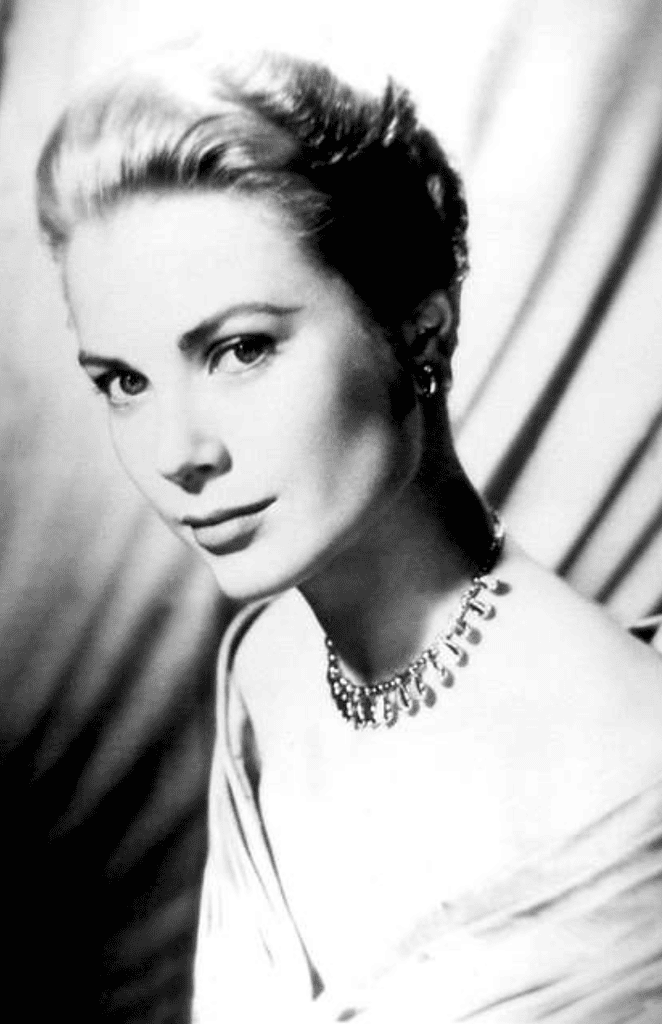
Photo of Grace Kelly, courtesy Wikimedia Commons.
Grace Kelly
The famed Grace Kelly—Hollywood movie star-turned-princess-of-Monaco—grew up in the East Falls section of the city, in a sprawling brick Colonial that still stands, and has been recently renovated. (You can’t tour it, alas—but you can visit the historical marker outside.) Born as a Philadelphian in 1929, Kelly moved to New York as a young woman, then made her film debut in 1951 in the movie Fourteen Hours. She achieved fame the very next year in Fred Zinnemann’s western, High Noon; the year after that, she starred in Mogambo, which won her an Oscar nomination; and the year after that, she won the Oscar for The Country Girl. The acclaimed actress, international icon and Hitchcock’s muse retired from her film career at the age of 26 (!!) to marry Prince Rainier III of Monaco, giving the world (and her Philly fans) a society wedding—the “wedding of the century”—that attendees still talk about and history remembers as one of its most elegant royal nuptials ever.
As a princess, she was a world-famous philanthropist, and remained until her death at age 52 a beloved symbol of beauty, glamour and talent. The whole world seemingly loved and loves her, but her role here in our city—Philly’s real live princess—has endeared her on a personal level to her hometown. Interesting trivia here: The stunning and scenic Kelly Drive, upon which Boathouse Row sits, is named after Grace’s brother, John B. Kelly—an Olympic rower and three-time city councilman in Philly.
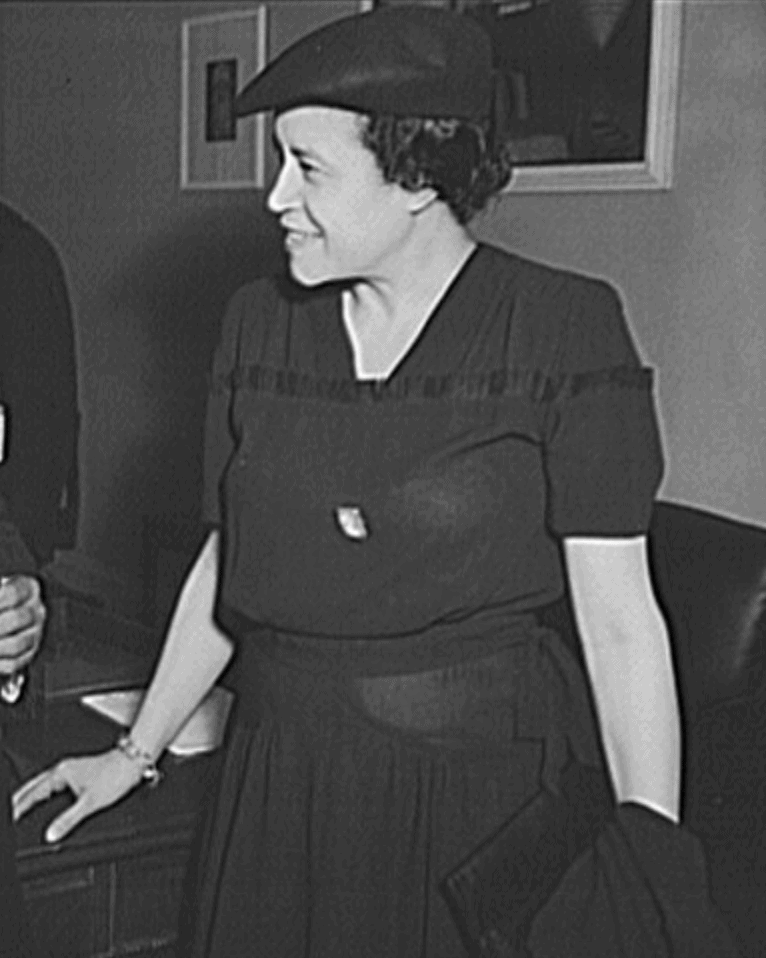
Photograph of Crystal Bird Fauset by Roger Smith from the Library of Congress Archives
Crystal Bird Fauset
This driven, dynamic Philly-based civil rights activist, teacher and political force was, in 1938, the very first Black woman elected to the U.S. state legislature. She was born in Maryland and raised in Boston, but spent most of her life here in Philly, where, long before she worked in politics, she had a career as a public school teacher. But her life, even then, was driven by the need to make change. In 1926, she joined the Interracial Section of the American Friends Service Committee—the Quakers—hoping to advance “the humanness of the Negro” in the eyes of the population. Over the next couple years, she traveled and lectured for the Friends, giving some 200 speeches on race relations.
In 1932, Faucet founded the Colored Women’s Activities Club for the Democratic National Committee, helping register Black women to vote and get involved in politics—work that quickly launched her into a role in the Roosevelt administration as the Director of the Women and Professional Professional Project for Philly’s Works Progress Administration and as a member of the Federal Housing Advisory Board. She became a friend of Eleanor Roosevelt’s.
This remarkable woman continued to expand her reach, helping to launch Swarthmore’s College Institute of Race Relations, which aimed to “study and discuss the world problem of race and the factors which constitute the American inter-racial situation, with emphasis upon Negro-white relations.” Then, in 1938, she ran for and won a seat representing a district in Philly that was 66 percent white. (Regarding her win, as Billy Penn once reported, she noted: “I’ll not consider it a personal honor at all. I consider it rather a recognition of Negro womanhood.”) In her tenure, she focused on legislation that would boost women’s rights in the labor force, and improve public health and housing. She resigned this post after a year to go to work at the national level, as the race relations director of the U.S. Office of Civil Defense—an advisor in Roosevelt’s “Black Cabinet.” (Shortly after that, she left the Democratic Party, unhappy with the lack of progress on sending segregation, and went to bat for the Republican candidate, Thomas Dewey.)
Later on, after WWII, she helped launch the United Nations Council of Philadelphia (later the World Affairs Council), and then spent much of the rest of her life traveling around the world to support and befriend independence leaders, presidents, diplomats and thought leaders. In 1955—10 years before her death—the state of Pennsylvania awarded her a second Meritorious Service Medal/ Today, you can see a historical marker at her former West Philly home, at 54th and Vine.
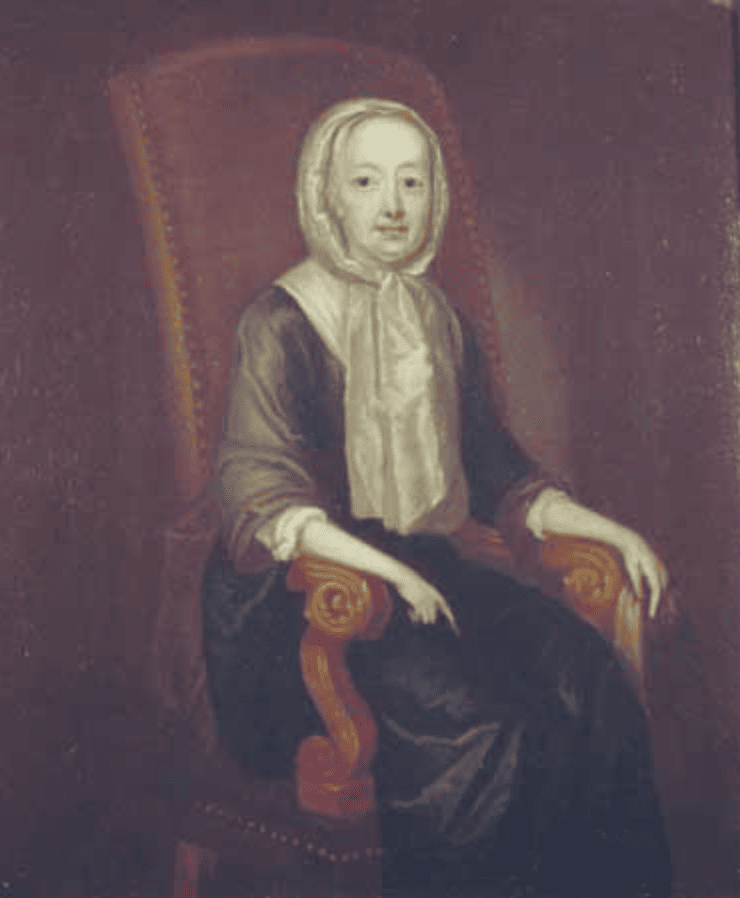
Portrait of Hannah Callowhill Penn by John Hesselius
Hannah Callowhill Penn
Everyone knows William Penn, of course—the Quaker founder of our great state of Pennsylvania. Less well-known? His wife, Hannah Callowhill Penn, who was essentially the first female governor in America, and the first woman to officially hold political power in the country. She’d left England to come to the state (well, the colony) with William shortly after they married in 1696 when she was 25; her family’s money helped keep Pennsylvania from bankruptcy more than once. They lived in both Philadelphia and a Bucks County Estate called Pennsbury Manor, just along the Delaware River.
After a series of strokes left William debilitated in 1712, Hannah essentially took over the running of the colony. When he died in 1718, she was officially the owner of the Province of Pennsylvania (and his estate), per his will, and continued to keep it up and running. There was drama there: William’s first son considered himself the rightful heir to all of this, and tried to override the will. He failed; Hannah—also a mother to nine, by the way—was the proprietor and de facto head of Pennsylvania until the age of 55.
Today, Philly’s Callowhill Street is likely the best-known part of her legacy. (It was William who named it for his wife, actually, in the 1680s.) You can also find a historical marker noting her role in history on 2nd Street, near Market. And Pennsbury Manor, the Penn’s Bucks County estate, is open to visitors. You can see the tour information here.
***
Want to book a room or suite—or book the entire house—at Guild House Hotel, a historic Philadelphia hotel in the heart of the city? Click here to plan your stay!
